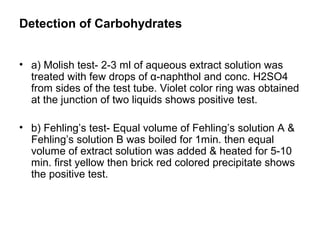Carbohydrates
- 1. CARBOHYDRATES ABU SUFIYAN CHHIPA B.R. NAHATA COLLEGE OF PHARMACY, SIRO, MANDSAUR
- 2. A carbohydrate is a large biological molecule, or macromolecule, consisting of carbon (C), hydrogen (H), and oxygen (O) atoms, usually with a hydrogen:oxygen atom ratio of 2:1 (as in water). They are called carbohydrates because the carbon, oxygen and hydrogen they contain are generally in proportion to form water with the general formula Cn (H2O)n.
- 3. Carbohydrate functions • Carbohydrates have several roles in living organisms, including energy transportation, as well as being structural components of plants and arthropods. • Carbohydrate derivates are actively involved in fertilization, immune systems, the development of disease, blood clotting and development. • carbohydrates can function as long term food storage molecules, as protective membranes for organisms and cells, and as the main structural support for plants and constituents of many cells and their contents.
- 4. Energy sources (glucose/glycogen) Structural elements • cell wall (plants, bacteria) • connective tissues • adhesion between cells
- 15. Extraction of Monosaccharide Fresh Plant Material Homogenized with 4 vol. of distilled water for 15 min Filtration – Filtrate is allow to concentrate in volume to 1/10th of its vol. Allow to crystallize in the refrigerator
- 16. Extraction of high mol. Weight Carbohydrates Plant Material is extracted with ethanol (which remove low mol wt constituents), Filter, collect the residue & extract with acetone followed by ether: benzene(1:1) to remove lipids Filtrate contain lipids, residue is extracted with 1 % NaCl Filter (Filtrate contain natural water soluble polysaccharides) Residue is extracted with 0.5 % ammonium oxalate sol. Filtrate on acidification Residue extract with NaCl than with ppt Pectin NaoH at room temp. for 24hr Filtrate on acidification Residue is wash & dry, gives Hemicellulose Pure Cellulose
- 17. Detection of Carbohydrates • a) Molish test- 2-3 ml of aqueous extract solution was treated with few drops of α-naphthol and conc. H2SO4 from sides of the test tube. Violet color ring was obtained at the junction of two liquids shows positive test. • b) Fehling’s test- Equal volume of Fehling’s solution A & Fehling’s solution B was boiled for 1min. then equal volume of extract solution was added & heated for 5-10 min. first yellow then brick red colored precipitate shows the positive test.
















